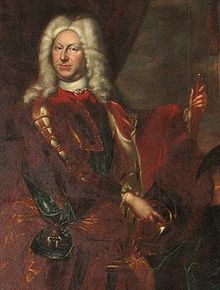Friedrich II. (Saxe-Gotha-Altenburg)
. Frederick II of Saxe-Gotha-Altenburg (born July 28 . Jul / 7. August 1676 greg. On Friedenstein Castle in Gotha ; † 23. March 1732 in Altenburg ) was a duke, a ruler in Thuringia . He came from the Ernestine - Wettin branch line Saxony-Gotha-Altenburg .
Life
Friedrich II. Was born the son of Duke Friedrich I of Saxe-Gotha-Altenburg and his wife Magdalena Sibylle , a born princess of Saxe-Weissenfels .
When his father died, Friedrich II was still a minor, so initially a guardianship and regency was formed under the dukes Bernhard I of Saxe-Meiningen and Heinrich von Saxe-Römhild . In 1693, after he had returned from a trip to Holland and England, he was declared of legal age by the Emperor and took office independently. Friedrich II was a pompous Baroque ruler , his court and the standing army, which he had taken over from his father and even expanded, devoured large sums of money. Frederick II therefore rented his soldiers to foreign princes, which brought him into great difficulties in 1702 when he rented his troops to Louis XIV of France, who used them against the emperor in the War of the Spanish Succession .
In terms of domestic policy, Frederick II essentially continued the policy of his predecessors. In 1717 he had the orphanage in Altenburg founded by his grandfather, Ernst the Pious , expanded and expanded. As early as 1705 he had made the establishment of the Altenburger Magdalenenstift , a noble fräuleinstift, possible.
Friedrich II set himself a permanent monument in his residence city of Gotha with the construction of the Friedrichsthal Palace named after him . Between 1708 and 1711 he had the summer palace built to the east below the fortifications of the Friedenstein Palace by the Duke of Gotha chief building director Wolf Christoph Zorn von Plobsheim (1655–1721) based on the model of the Versailles Palace . Behind the baroque three-wing complex he had an extensive baroque pleasure garden with statues and a grotto with fountains laid out, which is no longer preserved today. The Friedrichskapelle (today Friedrichskirche ), built by the Gothic builder Johann Erhard Straßburger , also owes its name to Friedrich II. In gratitude for an illness he had overcome in 1715, he had the church built in place of the dilapidated St. Nicholas Chapel on Erfurt Landstrasse.
In Gotha, Frederick II also had the orphanage planned by Ernst the Pious built and a church was added from 1710–1712. In 1726 he had a prison and madhouse built in Kahla . For 100,000 thalers from his private collection, he bought the famous numismatic collection of Prince Anton Günther von Schwarzburg-Arnstadt , which formed the basis of the coin cabinet that is still located in Schloss Friedenstein today. Since 1697 Frederick II had. Incidentally the Board on the Protestant church in the Electorate of Saxony held that it Elector Friedrich August I of Saxony (Augustus the Strong) had passed, as this account of his ascent of the Polish royal throne for the Catholic transgressed faith had.
By attacking parts of Saxe-Coburg (extinct 1699), Saxe-Eisenberg (extinct 1707) and Saxe-Römhild (extinct 1710), Frederick II succeeded - albeit only after long disputes among the Ernestinians, which only came with an arbitration award in 1735 of the emperor finally came to an end - each time to achieve territorial gains for his country.
Friedrich II found his final resting place in the princely crypt of the castle church on the Gothaer Friedenstein, which his father laid out in 1679/80 .
family
Friedrich II. Had been married to Magdalena Augusta (1679–1740), a daughter of Prince Karl Wilhelm von Anhalt-Zerbst , since 1696 . With this he had 18 children, of whom seven sons and two daughters reached adulthood:
- Sophie (1697-1703)
- Friedrich III. (1699–1772), Duke of Saxe-Gotha-Altenburg ⚭ 1729 Princess Luise Dorothea of Saxe-Meiningen (1710–1767)
- Wilhelm (1701–1771) ⚭ 1742 Princess Anna of Schleswig-Holstein-Gottorp (1709–1758)
- Karl Friedrich (1702–1703)
- Johann August (1704–1767) ⚭ 1752 Countess Louise Reuss zu Schleiz (1726–1773) (widow of Christian Wilhelm)
- Christian (* / † 1705)
- Christian Wilhelm (1706–1748) ⚭ 1743 Countess Louise Reuss zu Schleiz (1726–1773)
- Ludwig Ernst (born December 29, 1707; † August 13, 1763), Lieutenant General of Munster
- Emanuel (1709-1710)
- Moritz (born May 11, 1711; † September 3, 1777), regent in Saxony-Eisenach , lieutenant general in Hesse-Kassel
- Sophie (* / † 1712)
- Karl (1714-1715)
- Friederike (1715–1775) ⚭ 1734 Duke Johann Adolf II of Saxony-Weißenfels (1685–1746)
- Magdalene Sibylle (* / † 1718)
- Augusta (1719–1772) ⚭ 1736 Prince Friedrich Ludwig of Hanover , Prince of Wales (1707–1751)
- Johann Adolf (1721–1799), Elector General Lieutenant
See also
literature
- August Beck : Friedrich II., Duke of Saxe-Gotha and Altenburg . In: Allgemeine Deutsche Biographie (ADB). Volume 8, Duncker & Humblot, Leipzig 1878, pp. 3-5.
- Christian Ferdinand Schulze : Life of the Duke of Saxe-Gotha and Altenburg Friedrich II. Gotha 1851, ( digitized ).
Web links
Individual evidence
- ↑ pons asini: Former Augustinian Collegiate Church of St. Mary, Altenburg
- ^ History and description of the Duchy of Gotha, Volume 2 , 1779.
| predecessor | Office | successor |
|---|---|---|
| Friedrich I. |
Duke of Saxe-Gotha-Altenburg 1691 - 1732 |
Friedrich III. |
| personal data | |
|---|---|
| SURNAME | Friedrich II. |
| ALTERNATIVE NAMES | Saxe-Gotha-Altenburg, Friedrich II. Von |
| BRIEF DESCRIPTION | Duke of Saxe-Gotha (1691–1732) |
| DATE OF BIRTH | August 7, 1676 |
| PLACE OF BIRTH | Gotha |
| DATE OF DEATH | March 23, 1732 |
| Place of death | Altenburg |

